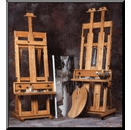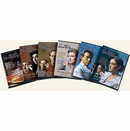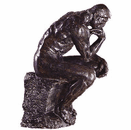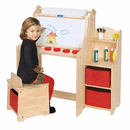Tips for Portraiture Drawing and Painting
Tips for Portraiture Drawing and Painting
Portraiture drawing and painting is an ageless form of art. For some, this project comes naturally with very little difficulty. However, for the rest of us, we may hit the nail on the head with the basic structure; yet completely miss the realness of the portrait when creating the features. Aggravating as this may be, there is hope!
If drawing or painting from a photo, you may simply need to look at it from a different perspective to force yourself to really notice the shape and design of the features. Try the following tips the next time you find yourself in a bit of a rut:
As previously mentioned, looking at the photo differently will draw more of your attention to the features. First, grab a separate piece of drawing paper and a sketch pencil. You are going to completely ignore the color for now and solely focus on the depth and shape of the facial features.
Park yourself comfortably at a table and make sure you have a suitable light source that does not shine directly on to the photo, rather from an angle on either side. This will help highlight those features and the areas you need to focus on that will bring your portrait to life. Once you are comfortably situated, you are going to take that photo you are drawing from and turn it upside down. This may seem odd to you; however, you will be surprised how much of a difference turning the photo upside-down will make!
Before you start drawing, take a minute to really examine the features and their placement. What shape are the eyes; are they oval, square? Are they uniform in shape, or does each of the eyes have their own “personality?” Focus on the shape of the face; is it oval, square, triangular, etc? Pay attention to the tilt of the head. Take your sketch pencil and measure the features and their relation to the placement of other feathers. If you are looking at a portrait straight on, with no tilt, generally a good rule of thumb is that the length of an eye is equal to the gap between the two eyes and also the distance from the outer corner of the eye to the edge of the face.
Now that you have studied the structure of the face, the placement of the features and the relation of other features, begin by lightly sketching the general structure of the face. After you have the basic outline of the face, lightly sketch the fundamental form of the features in their specific placement. Once you have done these two steps, sit back a moment and consider what you have accomplished. Being that the eyes are the main focus of anyone’s face, this is the area you will work on first. You will sketch in the details, including the shading. Work your way out from the eyes once you have finished them. Move on to either the eyebrows or the nose and continue moving out until you have finished.
When you have made your final touches, turn both the photo and your portrait right side up. How does it look? Some of you may find that you did better; others may find that it looks “ok.” The point of this exercise is it to take a moment and look at the project from a different point of view. You will have gotten in more practice and you will have a better grasp of the face. When you feel you are more comfortable, have another try at the final portrait. You may find that you have a sort of “writers block” when drawing or painting, simply take a break and step away from the project all together. Go somewhere that you will be unable to easily see the portrait and concentrate on another task for a few minutes. If you try to continue working, you will get more frustrated and will more than likely make hasty additions that will ultimately make the frustrations worse. Have fun with the project and do not make yourself stressed over it. Take your time and enjoy your project.
As previously mentioned, it is a great idea to keep in mind that you need a suitable light source when you are painting or drawing. It can make an immense difference, especially when you are working on a portrait. When your subject is not properly illuminated, you will more than likely miss important details that will make the world of difference in your project. For example, The Daylight PROFESSIONAL ARTISTS Lamp is a great idea to consider. This innovative light source mixes functionality with style, combining the latest in daylight simulation technology with the grace of a contemporary accent piece.
Try out this tip for your portraitures and keep in mind that you need a light source that will do your artwork justice.
Portraiture drawing and painting is an ageless form of art. For some, this project comes naturally with very little difficulty. However, for the rest of us, we may hit the nail on the head with the basic structure; yet completely miss the realness of the portrait when creating the features. Aggravating as this may be, there is hope!
If drawing or painting from a photo, you may simply need to look at it from a different perspective to force yourself to really notice the shape and design of the features. Try the following tips the next time you find yourself in a bit of a rut:
As previously mentioned, looking at the photo differently will draw more of your attention to the features. First, grab a separate piece of drawing paper and a sketch pencil. You are going to completely ignore the color for now and solely focus on the depth and shape of the facial features.
Park yourself comfortably at a table and make sure you have a suitable light source that does not shine directly on to the photo, rather from an angle on either side. This will help highlight those features and the areas you need to focus on that will bring your portrait to life. Once you are comfortably situated, you are going to take that photo you are drawing from and turn it upside down. This may seem odd to you; however, you will be surprised how much of a difference turning the photo upside-down will make!
Before you start drawing, take a minute to really examine the features and their placement. What shape are the eyes; are they oval, square? Are they uniform in shape, or does each of the eyes have their own “personality?” Focus on the shape of the face; is it oval, square, triangular, etc? Pay attention to the tilt of the head. Take your sketch pencil and measure the features and their relation to the placement of other feathers. If you are looking at a portrait straight on, with no tilt, generally a good rule of thumb is that the length of an eye is equal to the gap between the two eyes and also the distance from the outer corner of the eye to the edge of the face.
Now that you have studied the structure of the face, the placement of the features and the relation of other features, begin by lightly sketching the general structure of the face. After you have the basic outline of the face, lightly sketch the fundamental form of the features in their specific placement. Once you have done these two steps, sit back a moment and consider what you have accomplished. Being that the eyes are the main focus of anyone’s face, this is the area you will work on first. You will sketch in the details, including the shading. Work your way out from the eyes once you have finished them. Move on to either the eyebrows or the nose and continue moving out until you have finished.
When you have made your final touches, turn both the photo and your portrait right side up. How does it look? Some of you may find that you did better; others may find that it looks “ok.” The point of this exercise is it to take a moment and look at the project from a different point of view. You will have gotten in more practice and you will have a better grasp of the face. When you feel you are more comfortable, have another try at the final portrait. You may find that you have a sort of “writers block” when drawing or painting, simply take a break and step away from the project all together. Go somewhere that you will be unable to easily see the portrait and concentrate on another task for a few minutes. If you try to continue working, you will get more frustrated and will more than likely make hasty additions that will ultimately make the frustrations worse. Have fun with the project and do not make yourself stressed over it. Take your time and enjoy your project.
As previously mentioned, it is a great idea to keep in mind that you need a suitable light source when you are painting or drawing. It can make an immense difference, especially when you are working on a portrait. When your subject is not properly illuminated, you will more than likely miss important details that will make the world of difference in your project. For example, The Daylight PROFESSIONAL ARTISTS Lamp is a great idea to consider. This innovative light source mixes functionality with style, combining the latest in daylight simulation technology with the grace of a contemporary accent piece.
Try out this tip for your portraitures and keep in mind that you need a light source that will do your artwork justice.
Copyright © 2002-2025 Madison Art Shop™ LLC. All Rights Reserved.

















